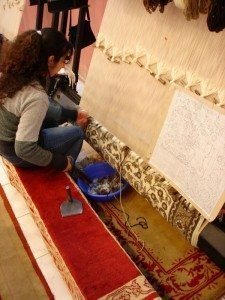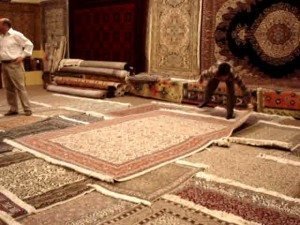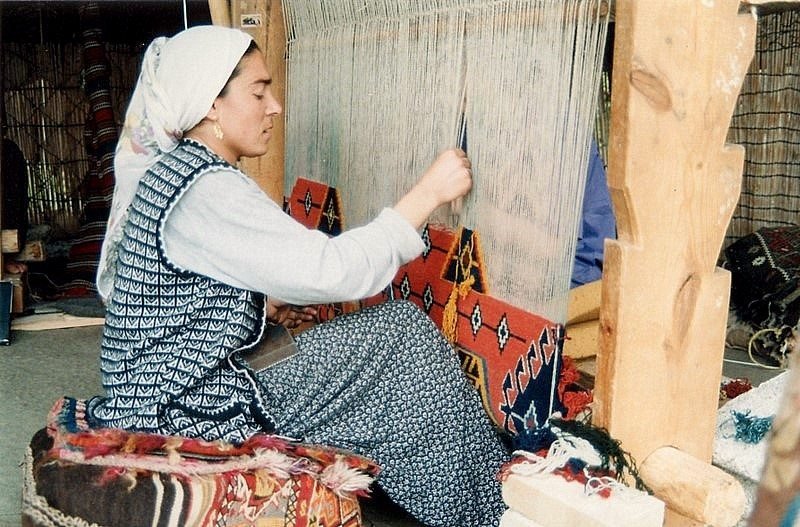A Sultan-sized Souvenir: Buying a Turkish Carpet
 It’s the most beautiful thing you will ever walk all over. Much more than a trinket or a shell with a destination name etched in the side, this memento will become a part of your home. If you are looking for something to bring back from your trip to Turkey, a carpet should be high on your list.
It’s the most beautiful thing you will ever walk all over. Much more than a trinket or a shell with a destination name etched in the side, this memento will become a part of your home. If you are looking for something to bring back from your trip to Turkey, a carpet should be high on your list.
Before moving into Anatolia—what is now modern Turkey—the Turks were a nomadic people living in Central Asia, cousins, you might say, to Genghis Khan. Evidence of carpet making dates as far back as the 4th century B.C. The carpet was perfectly suited to the nomadic life as it could be rolled and taken on the next journey. Durability and beauty were important as the rug was the literal foundation of the home, and each tribe developed its own patterns and methods. Even today an expert can tell you in what region a piece was made by closely examining the details of the craftwork.
These carpets are not simply quaint leftovers from old ways being sold to tourists as souvenirs. Many modern Turkish families maintain a carpet in their home. Some will tell you it was their grandparents’ or great grandparents’ yet the condition of the colors and the fabric might make that seem impossible. The truth is that a well made Turkish carpet, even one subjected to moderate foot traffic in your living or dining room, should last several generations.
 By tradition the carpets were made by women, and carpet makers with the greatest skill drew admiration and perhaps a good husband. Today, however, this is a commercial venture, and those pieces that are still made by hand—and you should be sure of this before buying—are made by village women earning a wage and adapting styles and patterns to suit the demands of the buyers.
By tradition the carpets were made by women, and carpet makers with the greatest skill drew admiration and perhaps a good husband. Today, however, this is a commercial venture, and those pieces that are still made by hand—and you should be sure of this before buying—are made by village women earning a wage and adapting styles and patterns to suit the demands of the buyers.
The carpets are made on a loom. Knots are tied in rows across the warp, the vertical fibers of the base of the carpet, while the wefts are pulled down on each row of knots. The knots are then cut with a scissors to make an even depth to the pile. The Turkish knot is a double knot which encircles two strands of the warp, as opposed to the single Persian knot which only encircles one. The Turkish style renders better durability.
HOW TO SHOP
If you want to buy a Turkish carpet, be prepared to drink some tea. There are the carpet sellers who will try to hard sell you a carpet, but more often than not all negotiations or even just the “to look is free” showings typically begin with a friendly glass of traditional tea (or apple tea, which is a favorite of the tourists).
 The best carpets are 100% wool; the cotton ones are cheaper and will not last. Check the fringes on the edge to be sure. Silk might also be worked into some carpets giving it a nice sheen. The silk carpets can be stunning, but so can the prices. You can make sure you have silk or wool by burning a fiber. (Just make sure that fiber came from the actual carpet right before your eyes!) Wool and silk will smolder, give off a peculiar odor like burnt hair. Cotton will smell like burning paper and will catch a flame easily.
The best carpets are 100% wool; the cotton ones are cheaper and will not last. Check the fringes on the edge to be sure. Silk might also be worked into some carpets giving it a nice sheen. The silk carpets can be stunning, but so can the prices. You can make sure you have silk or wool by burning a fiber. (Just make sure that fiber came from the actual carpet right before your eyes!) Wool and silk will smolder, give off a peculiar odor like burnt hair. Cotton will smell like burning paper and will catch a flame easily.
Just as we proverbially “sweep things under the rug” to hide them, the true value of your carpet is on its hidden side. To be sure your carpet is hand-knotted on a loom, look to see that the knots are not perfect. Humans make mistakes; machines do not. Also the knot count should be greater than 120 in a square inch. The preferred symmetric Turkish knot will hide the warp and pull two strands of it together.
Colors should be as radiant as a Turkish spice market. Artificial dyes aren’t the end of the world, but the natural counterparts tend to be more vivid. If on the bottom of the rug or in the depth of the pile you find a richer color, then this carpet may be faded. But don’t confuse color variance within the pile with fading. Fluctuation in tone indicates natural pigments, while uniformity suggests synthetics. Natural dyes draw a higher price than chemical ones as they hold their hue better over time.
 Be aware of old rugs. Yes, with a good cleaning grandma’s carpet can be sold like new to the unwary buyer. New rugs will show tight knots.
Be aware of old rugs. Yes, with a good cleaning grandma’s carpet can be sold like new to the unwary buyer. New rugs will show tight knots.
In the end, the real test of the carpet is this: do you like it? If you have a chance before your trip, measure the room you will use it in and give consideration to what colors are going to go with your décor. Bringing along a photo is a good idea, but I have even emailed digital photos of carpets home to friends and family which made it possible for them to buy through me from halfway round the world.
HAGGLE!
Remember, you can drink gallons of tea, but you are never obliged to buy. And the sellers may roll out dozens of carpets until the stack raises the floor about a foot, but there is really only one important rule of conduct: do not haggle unless you intend to buy. When the seller gives in to the price you offered, you should be prepared to roll out the dough (or more likely, credit card).
Prices can sometimes vary quite a bit with the seller. Surely it depends on how much the original price was from the maker and how greedy or needy the seller is. Plus if someone found you in the street, suddenly remembers that his uncle sells carpets, and then brings you to the shop, you can bet a commission will be figured into the price as well. Paying cash might also be cheaper as credit card sales sometimes incur an extra fee.
 Make sure you know how much it costs to have it shipped (if you go that route) or how much you may have to pay at customs if you exceed your duty tax exemption when you bring it home. (Insider tip: You didn’t hear it from me, but a lot of carpet sellers will give you two receipts: the real one for what you paid, and the bargain basement priced one for customs.) Don’t look at your vendor like he is crazy if he tells you to simply fold the carpet up to carry home. Carpets won’t be damaged by such treatment and actually fit quite nicely into special handbags that the shop will have on hand. If your vendor ships your carpet, it is advisable that you take a photo of it and get a receipt in case the wrong carpet shows up at your door or not at all.
Make sure you know how much it costs to have it shipped (if you go that route) or how much you may have to pay at customs if you exceed your duty tax exemption when you bring it home. (Insider tip: You didn’t hear it from me, but a lot of carpet sellers will give you two receipts: the real one for what you paid, and the bargain basement priced one for customs.) Don’t look at your vendor like he is crazy if he tells you to simply fold the carpet up to carry home. Carpets won’t be damaged by such treatment and actually fit quite nicely into special handbags that the shop will have on hand. If your vendor ships your carpet, it is advisable that you take a photo of it and get a receipt in case the wrong carpet shows up at your door or not at all.
My approach to buying is this: if it is something I will enjoy, the quality is acceptable, and the price seems reasonable to me – consider how costly they are in your home country – then it is a good deal. You can’t beat yourself up over a couple hundred dollars when you are getting something worth over $3000 at home at half the price in Turkey. Plus you have the story of the purchasing adventure to tell, which is generally priceless. That being said, don’t buy anything without a good bit of haggling.
 In haggling, never be sure you like the price. Don’t panic when you hear the first figure—they may start as high as three times what the final price tag will be. Have an idea of how much you are willing to spend. Never answer the question “How much do you think this is worth?” and don’t be afraid to say you probably aren’t buying today or to make attempts to walk away.
In haggling, never be sure you like the price. Don’t panic when you hear the first figure—they may start as high as three times what the final price tag will be. Have an idea of how much you are willing to spend. Never answer the question “How much do you think this is worth?” and don’t be afraid to say you probably aren’t buying today or to make attempts to walk away.
When the seller throws up his hands and sighs, you will be the proud new owner of a beautiful Turkish carpet.
_______________________________________
Read more travel adventures over on my blog at Revtravel.com




 ORDER YOUR COPY TODAY!
ORDER YOUR COPY TODAY! ORDER YOUR COPY TODAY!
ORDER YOUR COPY TODAY!
Good advice, you sound like an expert alright. Haggling over price is practically a tourist obligation these days, but telling the tourist that the etiquette is actually not to haggle unless you really intend to buy – rather than just haggling ‘for a laugh’ but in a manner ultimately insulting to the seller if not engaged in seriously – is the kind of insight that only someone who knows what they’re talking about would say.
Keep up the good work. We sell authentic oriental rugs too to the Irish market from our shop in Dublin. Please drop by our site http://www.forfloors.ie and leave a comment – always interested in what fellow experts have to say.
I was in Turkey 10 years ago. I was in Urgup and the when I bought my carpet he want 800 dollars. I said no, I can only pay 250. He started yelling, do you think i am crazy, its way to low. I then showed him $275 and he took it in a heartbeat. They yell and scream but they do not bite
Ha, I love it! Yes, cash speaks its own language and is hard to turn down when it’s out on the table. Sounds like he still probably did all right on that deal. Everyone’s happy.
Pingback: Weekly Roundup: Top 5 Turkey Travel Posts |
Pingback: Do You Buy Local Crafts When You Travel?
Pingback: Cappadocia, Turkey: In the Land of the Fairy Chimneys
Pingback: Photo Gallery: Cappadocia, Turkey
I personally could not tell you if a carpet was old or new but I did have a third generation carpet buy tell me some tips. Single knot is not better than dounble knot, just different places use different knot. Wool on cotton, wool on wool with natural dye will last for many generations. Make sure if they say its silk that it is silk sometimes polyester. If you get a natural dye carpet more than 50 years old except to pay more than $4,000. If you get a Pakistani carpet you can get for around $1000. Just because you go to factory does not mean you are not gettıng a Turkish or Iranian carpet you may still get a Pakıstani or even carpet from China carpet.